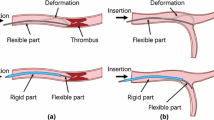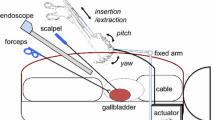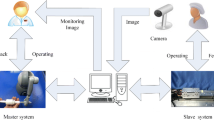Abstract
Purpose
Image guidance is a key technology that can improve the outcome of laparoscopic surgery. However, due to the large deformation caused by digestive organs, a computer-aided navigation system based on preoperative imaging data cannot indicate the correct target position of the lesion (e.g., liver tumors and vessels invisible from the organ surface). To overcome this issue, we developed a laparoscopic ultrasound manipulator with two motorized degrees of freedom at the tip, allowing for the performance of a dexterous ultrasound scan in a confined laparoscopic surgical area.
Method
The developed manipulator consists of a compact and elastic structure using springs, enabling a safe ultrasound scan and avoiding excess force on the inspected organs. The manipulator is a handheld device equipped with four buttons at the handle, which the surgeon directly grasps to send a motion command to the tip structure. The developed prototype realizes two motorized degree-of-freedom motion at the tip. The size of prototype is 15.0 mm in diameter that is usable in conventional laparoscopy. The tip of the manipulator was carefully designed by considering the kinematic model and the results of the finite element analysis.
Results
To assess the prototype, accuracy and rigidity were measured by using a motion processing microscope. The accuracy test showed that the proposed device has a fairly accurate characteristic as a handheld device. This was supposedly caused by the nature of compliant mechanism, which does not have mechanical play in motion. In addition, the intrinsic elastic structure (approximately 2.0 N/mm in most of the range of motion) allowed the ultrasound probe to adequately fit on the curved organ surface without extra effort of manipulation during the inspection. In the in vivo experiment, the yaw motion was found to be effective for investigating the vascular network because the manipulator allows the probe to be rotated while maintaining the same position.
Conclusion
The mechanical evaluation and in vivo test results showed high feasibility of the prototype. We are currently working on further mechanical improvement for commercialization and development of a real-time navigation system that can perform three-dimensional reconstruction of ultrasonographic images by implementing a magnetic position sensor at the tip of the manipulator.














Similar content being viewed by others
References
Konishi K, Nakamoto M, Kakeji Y, Tanoue K, Kawanaka H, Yamaguchi S, Ieiri S, Sato Y, Maehara Y, Tamura S, Hashizume M (2007) A real-time navigation system for laparoscopic surgery based on three-dimensional ultrasound using magneto-optic hybrid tracking configuration. Int J CARS 2:1–10
Nicolau S, Soler L, Mutter D, Marescaux J (2011) Augmented reality in laparoscopic surgical oncology. Surg Oncol 20(3):189–201
(2016) http://www.sages.org/publications/guidelines/guidelines-for-the-use-of-laparoscopic-ultrasound/. Accessed 30 Jan 2018
Oguri S, Arata J, Ikeda T, Nakadate R, Onogi S, Akahoshi T, Harada K, Mitsuishi M, Hashizume M (2015) Multi-degrees of freedom laparoscopic ultrasound probe with remote center of motion. Int J CARS 10(Suppl 1):S242–244
Arata J, Kogiso S, Sakaguchi M, Nakadate R, Oguri S, Uemura M, Cho B, Akahoshi T, Ikeda T, Hashizume M (2015) Articulated minimally invasive surgical tool for laparoscopy based on compliant mechanism. Int J CARS 10:1837–1843
Arata J, Saito Y, Fujimoto H (2010) Outer shell type 2 DOF bending manipulator using spring-link mechanism for medical applications. In: Proceedings of international conference on robotics and automation, pp 1041–1046
Denadai R, Toledo AP, Bernades DM, Diniz FD, Eid FB, Lanfranchi LM, Amaro LC, Germani NM, Parise VG, Pacheco Filho CN, Saad-Hossne R (2014) Simulation-based ultrasound-guided central venous cannulation training program. Acta Cir Bras 29(2):132–144
(2017) https://www.intuitivesurgical.com/products/da-vinci-xi/. Accessed 30 Jan 2018
(2017) http://www.hitachi-aloka.com/applications/surgery/laparoscopic-surgery. Accessed 30 Jan 2018
(2017) https://bkultrasound.com/applications/surgery/laparoscopic-ultrasound-for-surgery/. Accessed 30 Jan 2018
Sandrin L, Fourquet B, Hasquenoph JM, Yon S, Fournier C, Mal F, Christidis C, Ziol M, Poulet B, Kazemi F, Beaugrand M, Palau R (2013) Transient elastography: a new noninvasive method for assessment of hepatic fibrosis. Ultrasound Med Biol 29(12):1705–1713
Sato H, Harada K, Arata J, Oguri S, Onogi S, Ikeda T, Hashizume M, Mitsuishi M (2016) Design and prototyping of handheld 3-DOF laparoscopic ultrasound manipulator. Procedia CIRP 49:121–124
Takachi Y, Masuda K, Yasunaga T, Aoki Y (2011) Development of support system for handling ultrasound probe to alleviate fatigue of physician by introducing a coordinated motion with robot. J Robot Soc Jpn 29(7):634–642 (in Japanese)
Onogi S, Ikeda T, Arata J, Nakadate R, Oguri S, Akahoshi T, Harada K, Mitsuishi M, Hashizume M (2016) Intra-operative three dimensional ultrasound reconstruction and visualization for endoscopic liver surgery. Int J CARS 11(Suppl 1):S256–257
Onogi S, Nakadate R, Arata J, Akahoshi T, Ikeda T, Hashizume M (2017) Technical trial of GPGPU volume reconstruction by using a tablet PC for practical clinical navigation system. Int J CARS 12(1):S96–97
Acknowledgements
This research was supported by Japan Agency for Medical Research and Development (AMED), Research on Development of New Medical Devices (15hk0102005h0002).
Author information
Authors and Affiliations
Corresponding author
Ethics declarations
Conflict of interest
Jumpei Arata, Kazunari Fukami, Susumu Oguri, Tetsuo Ikeda, Ryu Nakadate, Shinya Onogi, Masamichi Sakaguchi, Kanako Harada, Mamoru Mitsuishi, and Makoto Hashizume declare that they have no conflict of interest.
Human and animal rights
This article does not contain any studies with human participants performed by any of the authors. All procedures performed in studies involving animals were in accordance with the ethical standards of the institution or practice at which the studies were conducted.
Rights and permissions
About this article
Cite this article
Arata, J., Fukami, K., Oguri, S. et al. Laparoscopic ultrasound manipulator with a spring-based elastic mechanism. Int J CARS 13, 1063–1072 (2018). https://doi.org/10.1007/s11548-018-1709-7
Received:
Accepted:
Published:
Issue Date:
DOI: https://doi.org/10.1007/s11548-018-1709-7




